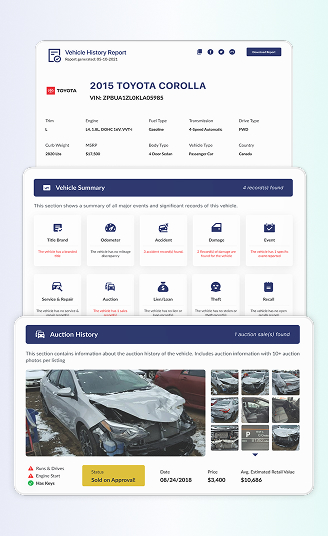Key takeaways:
- Suicide doors are rear-hinged doors that open toward the back of the car, giving a distinctive look and handy access.
- If you want one, look at luxury models or specialised cars with the feature, such as Rolls-Royce Phantom or Mazda RX-8.
- For modern cars, you can run the VIN decoder service to check the history of a high-end vehicle like the Rolls-Royce Phantom.
What are Suicide Doors for Cars?
The suicide door is a rear-hinge door that opens from the back. The purpose is to make the entrance and exit easier for passengers without facing the centre pillar. This kind of door earned its name through a fear that the wind could catch an unlatched door while the car was moving, which could cause passengers to fly because seatbelts were not common back then.
Today, they appear mostly in luxury cars and trucks, designed with modern safety features and elegant styling.
A Brief History of the Suicide Door
Suicide doors, also called rear-hinged doors, first appeared in the early 1900s. The design came from horse-drawn carriages, which used doors that opened backwards to make it easier for passengers to get in and out.
By the 1930s, this door style became popular among many car makers, especially luxury brands like Rolls-Royce, which used it on models such as the original Phantom (1925). People liked suicide doors for their elegant look and easy access, which made them a symbol of style and class.
Why Are They Called Suicide Doors on Cars?
The spine-chilling name came from a chilling fact. If the car were moving and the rear-hinged door opened, the aerodynamic drag would open the door; then, the unlucky passenger would have to lean on the vehicle to reach the handle, then close the door before the force pulls them out of the car.
In the early days, cars were luxury items built for the rich, and unfortunately, safety wasn’t a concern. Most vehicles were not equipped with seatbelts and an adequate locking system, and both front and rear doors were often opened backwards.
Suicide Door Cultural Significance
The design became famous for its luxurious and dramatic look, especially on high-end cars like the Rolls-Royce Phantom.
Some car brands and enthusiasts prefer to use softer names like “coach doors” or “rear-hinged doors.” This shift shows how language and culture change over time as people are more aware of mental health issues. The ongoing discussion about the term highlights how even car design can reflect society’s evolving attitudes and the importance of respectful language.
Read also: Why are expensive cars so fast?
What Cars Have Suicide Doors?
Suicide doors are rare in modern cars, but they appear on the luxury models like Rolls-Royce and some classic cars. In recent years, only a small number of production vehicles have featured them, mostly from luxury brands.
Car Model | Years Produced |
Lincoln Continental | 1961–1969 |
Rolls-Royce Phantom | 2003–Present |
Mazda RX-8 | 2003–2012 |
Mini Clubman | 2007–2014 |
Saturn Ion Quad Coupe | 2003–2007 |
Honda Element | 2003–2011 |
Rolls-Royce Cullinan | 2018–Present |
BMW i3 | 2013–2022 |
Toyota FJ Cruiser | 2006–2014 |
Mazda MX-30 | 2020–Present |
Design and Functionality of Suicide Doors
Suicide doors combine bold aesthetics with practical design. Their rear-hinged opening offers easier cabin access and a timeless, elegant look that continues to inspire modern automotive styling and engineering.
Aesthetic and Aerodynamic Considerations
The suicide doors are also visually dramatic. When both the front and rear doors are open, they create a seamless “double-door effect,” emphasising the vehicle’s premium design. In some modern models, suicide doors are shaped to improve aerodynamic flow.
Safety Features and Challenges
Historically, suicide doors had safety drawbacks, as they could swing open unexpectedly if not latched properly. Now, manufacturers have addressed these risks with automatic latching systems.
Maintenance and Precautions
Technicians should inspect hinges, latches, and seals regularly, work on level surfaces, and use protective equipment when servicing the doors. Drivers are also advised not to open suicide doors while the vehicle is moving to ensure maximum safety.
Suicide Doors: Advantages and Disadvantages
Suicide doors (or rear-hinged doors) offer a unique blend of style and function, but they also introduce specific design challenges that keep them off most modern cars.
The Advantages of Suicide Doors
- Easy Entry & Exit: The backwards-hinged design allows rear-seat passengers to out of the vehicle directly.
- Dramatic Styling: The door has a distinctive aesthetic that enhances the vehicle’s look.
- Panoramic Views: By eliminating the central B-pillar, these doors give rear-seat passengers a more open and panoramic view of their surroundings.
The Disadvantages of Suicide Doors
- Safety History: The nickname “suicide doors” comes from historical safety concerns, as older versions risked swinging open and causing injury if unlatched while driving.
- Structural Integrity: Designing the door requires removing the B-pillar, which necessitates expensive structural reinforcement elsewhere to maintain the vehicle’s strength and rigidity.
- Cost and Practicality: Due to the complex mechanisms and structural demands, these doors are expensive to produce and are mostly limited to luxury or niche vehicles.
Read also: The impact of technology on the automotive industry
Types of Suicide Doors
Suicide doors usually refer to rear-hinged doors, but there are a few versions that use the same concept in different ways. These designs all open against the usual direction of traffic, offering a wider and more stylish entry.
Some carmakers call them coach doors, flex doors, or freestyle doors, depending on the model and design.
Rear Side Doors
- These are the most traditional type of suicide doors.
- Only the back doors are hinged at the rear, while the front doors open normally.
- This setup is common in classic and luxury vehicles because it gives passengers extra space to get in and out.
Examples: Rolls-Royce Ghost and Wraith, Lincoln Continental Coach Door Edition, Mazda RX-8, and Honda Element.
Clamshell Doors (B-Pillarless Design)
- In this version, both the front and rear doors open in opposite directions, creating one large opening without a central B-pillar.
- When closed, the doors lock directly into each other instead of the car frame.
- This design improves access to the rear seats and gives the vehicle a cleaner, sleeker side profile.
Examples: Mazda RX-8 and Honda Element.
Coach Doors (Luxury Variation)
- These are the large, elegant rear-hinged doors found mostly in premium and chauffeur-driven cars.
- They open wide to make it easy for passengers to enter and exit gracefully, adding a touch of sophistication.
Examples: Rolls-Royce models such as the Phantom and Ghost.
Other Door Styles Often Confused with Suicide Doors
Although they look similar or open in unusual ways, these doors have different mechanisms:
- Scissor Doors: Open vertically from hinges near the windshield (seen on Lamborghinis).
- Gullwing Doors: Swing upward from the roof, resembling bird wings (Mercedes-Benz 300 SL).
- Butterfly Doors: Lift diagonally upward and outward, pivoting near the A-pillar.
- Swan Doors: Open slightly upward and outward, often seen on luxury sports cars like Aston Martins.
Regulatory Changes and Safety Standards on Suicide Door
Recent safety regulations have redefined how suicide doors are used in modern cars. Updated standards focus on stronger latches and improved safety features, so these doors are much safer than they once were.
- Historical Safety Concerns: Rear-hinged doors (coach doors) historically faced scrutiny due to the risk of them opening accidentally. Modern engineering has fixed this with advanced latching systems and automatic locking mechanisms.
- Safety Mandates: Regulations like those from the NHTSA now require features such as door locks and warning labels to ensure passenger protection in all vehicles using these door types.
- DOT Modernisation: The U.S. Department of Transportation (DOT) is proposing new rules to revise safety standards that were based on the assumption of a human driver.
- Supporting Autonomy: These regulatory updates aim to relax mandates for manual controls (like pedals and steering wheels) in driverless vehicles.
- Industry Impact: The changes are welcomed by the automotive industry as they clear the path for the wider and safer deployment of robotaxis and fully automated vehicles, including those that may feature modern coach doors.
Conclusion
Suicide doors have changed a lot over time, from risky designs in early cars to stylish features in luxury models today. Modern versions use better locks, stronger hinges, and advanced sensors to make them safe and reliable. These doors still catch attention because they give cars a bold and elegant look that reminds people of classic designs.
If someone wants to check if a car came with special features like suicide doors or see its original MSRP and factory options, use can use a Window Sticker by VIN service. It’s a quick way to learn what the car looked like when it was new, helping buyers confirm its true value and design history.
Cars Suicide Door FAQs
Are suicide doors illegal on cars?
No, suicide doors are not illegal, but they must meet safety rules, including strong latches and locking systems. Most modern cars avoid them because of safety concerns, yet some luxury and special models still use them. Carmakers now often call them “coach doors,” “access doors,” or “freestyle doors.”
Why don't cars use suicide doors anymore?
Cars stopped using suicide doors mainly because of safety and design issues. They can open by accident while driving, and are harder to build safely without a B-pillar. Stricter safety laws and higher production costs also played a role. Though modern luxury cars sometimes bring them back, most everyday vehicles avoid them for practicality and safety reasons.
What is the new name for suicide doors?
The automotive industry now prefers the terms coach doors, clamshell doors, or simply rear-hinged doors as modern, less alarming alternatives to the outdated name “suicide doors,” which referenced the past danger.










